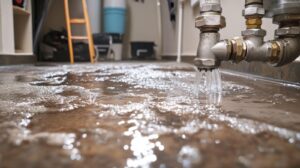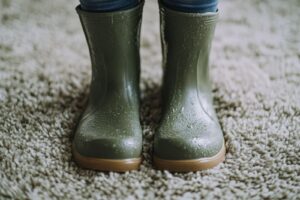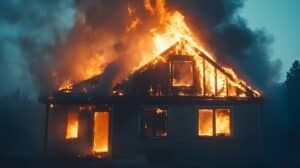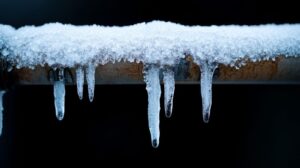We’ve all heard awful stories about the damage to buildings and the health issues that mold in drywall can cause. But how do you know if mold is in your home or office? After all, mold can grow almost anywhere.
Mold begins as microscopic spores that travel through the air. When those spores find a space that allows for growth, they begin to replicate. Mold thrives in warm, damp environments, so mold spores will quickly claim areas with those characteristics as their home.
Identifying mold can be tricky, but some places are more prone to mold, and if you suspect mold, it should be investigated quickly. However, mold is not always readily visible and needs a little more effort to be found. Here are four common signs of mold to be aware of and how to remove and prevent it.
Signs of Mold
Musty smell– Any living thing goes through different stages of growth, and mold is no exception. When mold is present and growing, it is also releasing different gases. Known as microbial volatile organic compounds (MVOCs), the MVOCs disperse through the air as they are emitted and can come into contact with other surfaces.
These MVOCs are the main culprit for the musty smell accompanying mold and mildew that can also lead to health issues like headaches, nausea, and dizziness. Some describe the smell as similar to damp soil, an old locker room, or wet fur.
So, if an area of your home starts to smell a bit funky, you’ll want to look closer to see if mold is growing there.
Dark stains– Mold can appear in many colors but is usually dark brown, black, or grey. It can sometimes be hard to differentiate from the dirt and grime found in most homes.
The difference, however, is that even after mold and mildew have been cleaned, the dark stains return very quickly and become larger or spread to other areas. These areas are usually accompanied by the musty smell described above.
Warped Walls– Sometimes mold can begin to grow under the surface, making it more challenging to identify if there is a problem. The surface tends to become warped or misshapen when mold grows under paint, wallpaper, flooring, or drywall. Having mold in drywall can cause structural damage and health problems.
Even if a surface has not experienced recent water damage, it can begin to warp as mold expands underneath. Pay close attention to surfaces that start to bubble or crack.
Allergy or Asthma Flare-Ups- Because mold spores exist in the air around us, we breathe them in all the time to a minimal degree. When more particles of mold and the accompanying MVOCs are present in the air, there’s a greater chance the mold will cause health issues.
People with allergies and asthma are more likely to experience symptoms when exposed to mold, but anyone can react to exposure. If you or someone else in the household experience allergy symptoms or respiratory problems, it might indicate mold in your house.
Mold Removal
Identify Source– Once you discover mold in your home, the next step is to determine where the mold is coming from, or more specifically, where the excess moisture is coming from, to allow mold to grow in that area.
This could be any source of water that comes in contact with the surface and could include a leaky pipe, unsealed window or roofing, or even a higher humidity level.
If the source of the excess moisture is not identified and resolved, there is a good chance the mold will return in the future, no matter how well you remove it in the present.
Clean– Cleaning mold can be challenging and problematic if you don’t know what you are doing. Using the correct products and protective equipment when cleaning and removing mold is essential. The EPA recommends that any area larger than 10 square feet should be handled by professional remediation experts.
Even if the area affected by mold is smaller than 10 square feet, it is still a good idea to get a consultation from a professional to ensure the problem is not more widespread than it appears. They can also offer advice on how to go about removing the mold and preventing it from returning.
When cleaning mold off of hard surfaces, it is best to scrub with a detergent that contains bleach and let it dry completely.
Replace– Removing mold can be almost impossible if mold affects softer or more absorbent surfaces. Carpet and ceiling tiles are best replaced instead of attempting to clean and remove the mold. Before installing the new materials, ensure the mold has been eliminated from the materials underneath.
You can’t just cover up mold in drywall with a new coat of paint. The entire sheet of drywall must be removed and replaced in many cases to ensure the mold will not return.
Prevent Mold
Humidity Levels– One of the best ways to prevent mold from growing in your home is to ensure the humidity level stays below 60 percent. Depending on your climate, this can be difficult, but a dehumidifier or air conditioner can help.
Clean spills– Even a small glass of spilled water can lead to mold if it is not cleaned up quickly and correctly. Often, water can find its way into the nooks and crannies of your home, which are also the perfect places for mold to grow.
Dry flooding– The first 48 hours are the most important to prevent mold from growing after flooding has occurred in your home. Whenever possible, ensure all areas affected by flooding are dried completely as quickly as possible.
This is especially important for carpeted areas. You must dry the carpet and the padding underneath completely to prevent mold and mildew from growing.
Black Diamond Water Damage & Restoration
The experienced experts at Black Diamond Water Damage & Restoration are available 24/7 to safely get rid of mold in drywall or anywhere else in your home.
Using proven best practices, Black Diamond will ensure the job is done right so that you and your family can stay safe and healthy and get your home back to normal as quickly as possible. Call now for a professional quote!
toto slot






